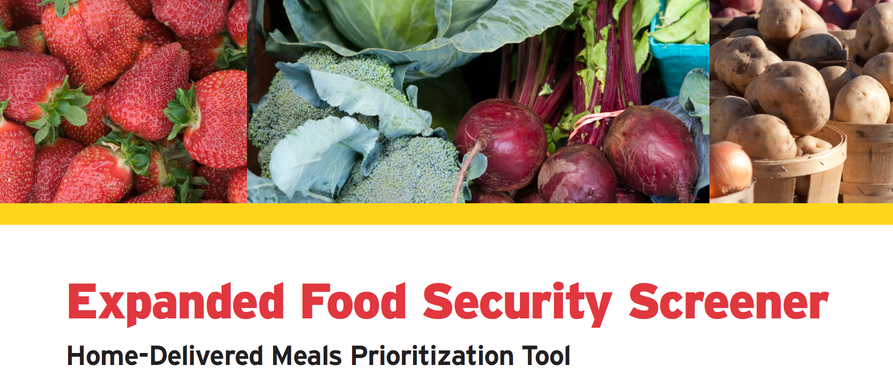What is Food Security?
According to the Food and Agriculture Organization, “food security exists when all people, at all times,
have physical and economic access to sufficient, safe, and nutritious food that meets their dietary needs and food preferences for an active and healthy life.”
The four main dimensions of food security are:
- availability (determined by food production and markets)
- accessibility (physical and economic)
- utilization (including the preparation of food)
- stability of the other three dimensions over time
What is the Expanded Food Security Screener?
Current tools for measuring food security only measure the economic access component. However, in older adults, and especially the homebound population, there may be physical issues that interfere with an individual’s ability to obtain and prepare adequate nutritious food. The Expanded Food Security Screener (FSS-Exp) builds on the US Department of Agriculture 6-item Household Food Security Survey Module (HFSSM), which is a validated tool used to assess food security based on questions that ask about ability to afford food. The FSS-Exp combines this economic access information with the other indicators of food security for older adults that indicate need for services: ability to get groceries into the home and ability to prepare meals. To fully understand an individual’s level of need for a meal, the FSS-Exp also takes into account whether the person has help available to accomplish these tasks.
How does the FSS-Exp work as a Home-Delivered Meals Prioritization Tool?
The FSS-Exp quickly gathers information on an individual’s economic access to food, their ability to get groceries into their home, and their ability to prepare meals, with or without help. This information is used to categorize applicants into one of five priority levels. The categorization scheme for these priority levels is based on the issues that could be specifically addressed by a meal delivered to the home. This tool provides home-delivered meal (HDM) programs with a concise version of the most essential information about each individual’s food security needs. HDM programs can use this information to make quick decisions about how to use their organization’s resources most efficiently and effectively to support the needs of that client, thus allowing the meal program to provide person-centered services.
What does screening mean and how is it different than assessment?
A screening tool is used to detect risk quickly and efficiently. When screening, you are trying to find those at the highest risk early on, in order to mitigate further decline. Assessment is more in-depth and thorough, but takes more time. This is why screening takes place before assessment, in order to quickly identify those who may be at high risk and thus in need of intervention. A follow-up assessment with those who are detected during screening will confirm, deny, and/or expand on the needs of an individual. Screening is less resource-intensive and tells you where to prioritize your more resource-intensive procedures (such as assessment and meals) in order to have the greatest impact.
